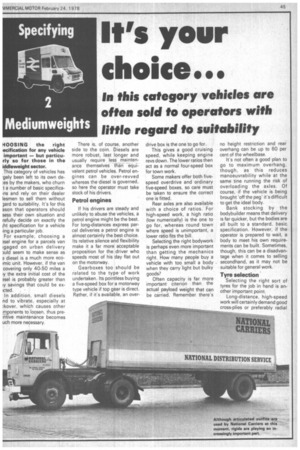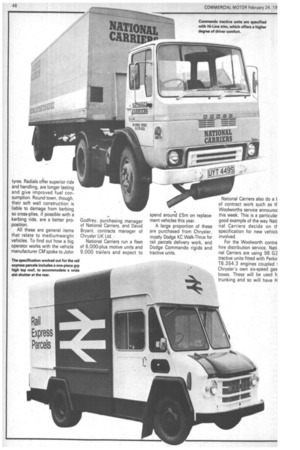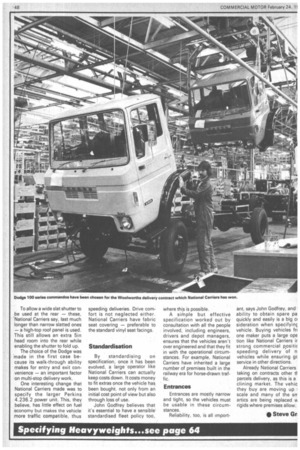It's your choice...
Page 47

Page 48

Page 49

Page 50

If you've noticed an error in this article please click here to report it so we can fix it.
In this category vehicles are often sold to operators with little regard to suitability
HOOSING the right ecification for any vehicle important — but particurly so for those in the iddleweight sector.
This category of vehicles has gely been left to its own de:es by the makers, who churn t a number of basic specificalis and rely on their dealer lesmen to sell them without jard to suitability. It's for this ason that operators should sess their own situation and refully decide on exactly the iht specification for a vehicle ling a particular job.
For example, choosing a ?sel engine for a parcels van igaged on urban delivery )uld seem to make sense as a diesel is a much more ecoimic unit. However, if the van covering only 40-50 miles a y the extra initial cost of the ?sel is probably greater than iy savings that could be ex cted. • In addition, small diesels nd to vibrate, especially at :kover, which causes other mponents to loosen, thus pre • ntive maintenance becomes uch more necessary.
There is, of course, another side to the coin. Diesels are more robust, last longer and usually require less maintenance themselves th-n equivalent petrol vehicles. Petrol engines can be over-revved whereas the diesel is governed, so here the operator must take stock of his drivers.
Petrol engines
If his drivers are steady and unlikely to abuse the vehicles, a petrol engine might be the best. For long-distances express parcel deliveries a petrol engine is almost certainly the best choice. Its relative silence and flexibility make it a far more acceptable proposition for the driver who speeds most of his day flat out on the motorway.
Gearboxes too should be related to the type of work undertaken. Its pointless buying a five-speed box for a motorway type vehicle if top gear is direct. Rather, if it's available, an over drive box is the one to go for.
This gives a good cruising speed, while keeping engine revs down. The lower ratios then act as a normal four-speed box for town work.
Some makers offer both fivespeed overdrive and ordinary five-speed boxes, so care must be taken to ensure the correct one is fitted.
Rear axles are also available with a choice of ratios. For high-speed work, a high ratio (low numerically) is the one to go for, whereas round town where speed is unimportant, a lower ratio fits the bill.
Selecting the right bodywork is perhaps even more important than getting the mechanics right. How many people buy a vehicle with too. small a body when they carry light but bulky goods?
Often capacity is far more important citerion than the actual payload weight that can be carried. Remember there's no height restriction and rear overhang can be up to 60 per cent of the wheelbase.
It's not often a good plan to go to maximum overhang, though, as this reduces manoeuvrability while at the same tine running the risk of overloading the axles. Of course, if the vehicle is being brought 'off the peg' it's difficult to get the ideal body.
Bank stocking by the bodybuilder means that delivery is far quicker, but the bodies are all built to a standard, basic specification. However, if the operator is prepared to wait, a body to meet his own requirements can be built. Sometimes, though, this can be a disadvantage when it comes to selling secondhand, as it may not be suitable for general work.
Tyre selection
Selecting the right sort of tyres for the job in hand • is another important point.
Long-distance, high-speed work will certainly demand good cross-plies or preferably radial tyres. Radials offer superior ride and handling, are longer lasting and give improved fuel consumption. Round town, though, their soft wall construction is liable to damage from kerbing so cross-plies, if possible with a kerbing ride, are a better pro-position.
All these are general items that relate to mediumweight vehicles. To find out how a big operator works with the vehicle manufacturer CM spoke to John Godfrey, purchasing manager of National Carriers, and David Bryant, contracts manager of Chrysler UK Ltd.
National Carriers run a fleet of 6,000-plus motive units and 9,000 trailers and expect to spend around E5m on replacement vehicles this year.
A large proportion of these are purchased from Chrysler, mostly Dodge KC Walk-Thrus for rail parcels delivery work, and Dodge Commando rigids and tractive units.
National Carriers also do a I, of contract work such as tt Woolworths service announc( this week. This is a particular good example of the way Nati nal Carriers decide on specification for new vehicli involved.
For the Woolworth contra hire distribution service. Nati, nal Carriers are using 98 G2 tractive units fitted with Perkir T6.354.3 engines coupled I Chrysler's own six-speed gea boxes. These will be used ft trunking and so will have H
For the 31 smaller rigid )(leis which are G13s, a 3.4m 3.25ft) wheelbase has been osen. Six-speed gearboxes again employed powered by rkins 6.354.2 diesel engines. wer steering, which is an Itional extra, has also been ecified on these rigids.
For the smallest of the hides, National Carriers ve chosen the Dodge Walkiru and five of these are to be ed. They will have 3.12m 0.25ft) wheelbase and be nit to the specification for rail Ice's delivery. This is a partilarly interesting specification hich was evolved over a imber of years by joint conltations between the makers Id National Carriers. To allow a wide slat shutter to be used at the rear — these, National Carriers say, last much longer than narrow slatted ones — a high-top roof panel is used. This still allows an extra 5in head room into the rear while enabling the shutter to fold up.
The choice of the Dodge was 'made in the first case because its walk-through ability makes for entry and exit convenience — an important factor on multi-stop delivery work.
One interesting change that National Carriers made was to specify the larger Perkins 4,236,2 power unit. This, they believe, has little effect on fuel economy but makes the vehicle more traffic compatible, thus speeding deliveries. Drive comfort is not neglected either National Carriers have fabric seat covering — preferable to the standard vinyl seat facings.
Standardisation
By standardising on specification, once it has been evolved, a large operator like National Carriers can actually keep costs down. It costs money to fit extras once the vehicle has been bought. not only from an initial cost point of view but also through loss of use.
John Godfrey believes that it's essential to have a sensible standardised fleet policy too, where this is possible.
A simple but effective specification worked out by consultation with all the people involved, including engineers, drivers and depot managers, ensures that the vehicles aren't over engineered and that they fit in with the operational circumstances. For example, National Carriers have inherited a large number of premises built in the railway era for horse-drawn traffic.
Entrances
Entrances are mostly narrow and tight, so the vehicles must be usable in these circumstances.
Reliability, too, is all import ant, says John Godfrey, and ability to obtain spare pa quickly and easily is a big cl sideration when specifyin,c vehicle. Buying vehicles fn one maker puts a large ope tion like National Carriers ir strong commercial positic speeding delivery of n vehicles while ensuring gc service in other directions.
Already National Carriers taking on contracts other t# parcels delivery, as this is a dining market. The vehic they buy are moving up scale and many of the srr artics are being replaced sn rigids where premises allow.
• Steve Gr




















































































































